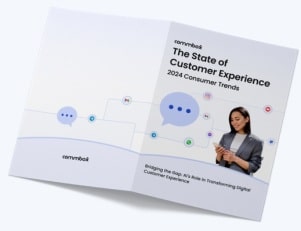The WhatsApp generation: younger shoppers urge brands to increase use of digital channels for customer service, says new survey.
• Survey reveals that 16-24-year-olds report WhatsApp as their top preference for contacting a brand, followed closely by Instagram
• Less than half (43%) of UK consumers say they have been ‘satisfied’ with the service received online over the past year
• 90% of 16-24-year-olds surveyed reported that they would take action after receiving a poor experience and are not afraid to take action to let others know

New research on UK customer service finds that 16-24-year-olds prefer to be met on their native channels, like WhatsApp and Instagram. This is an essential consideration for retailers targeting Gen Z, as the research also reveals Gen Z will publicly voice whether they have had positive or negative customer experiences, influencing potential future customers.
Commissioned by CommBox, a leading conversational AI-powered digital customer engagement platform, the survey of over 1,000 consumers and 250 managers in customer-facing organisations spotlights core consumer frustrations, providing valuable insight for brands seeking to deliver a better, more personalised service.
 Most customer service is missing the mark
Most customer service is missing the mark
Less than half (43%) of UK consumers say they have been ‘satisfied’ with the service received online over the past year, which is consistent across multiple age groups. Just 37% of 16-24-year-olds cited they were satisfied with the service they have received online, which only rises to 42% amongst over 55-year-olds.
Amongst all generations, issues such as long wait times, the inability to speak directly to a human agent, and using chatbots that can’t solve queries consistently came out top.
However, generational divides emerge when asked how brands could improve the experience. This is particularly the case when asked about channel preferences, with younger consumers preferring brands to be available across multiple touchpoints.
• As little as 34% of 16-24-year-olds prefer to call versus 61% of over 55s.
• 69% of those over 55s prioritise speaking to someone with the proper knowledge. In Gen Z this falls to less than 1 in 4, as they instead prioritize multichannel access (25%) and 24/7 availability (31%).
Brands echo these priorities. In alignment with 35-44 and over 55-year-olds, brands identified speaking to a knowledgeable agent as the most important factor for customers (44%). While also recognising that access to multiple channels (37%), and 24/7 resolution (35%) as vital customer service provisions.
 Negative reviews devastate retailers; Gen Z isn’t afraid to dish them out.
Negative reviews devastate retailers; Gen Z isn’t afraid to dish them out.
After a bad customer experience, 90% of Gen Z (16-24 year olds) say they will take action. This includes avoiding spending with that brand again (44%) and seeking a competitor (33%). But it doesn’t stop there; a bad review can dissuade potential customers with significant effects in the age of online shopping.
As the high street shutters and eCommerce booms, consumers face hundreds of choices online, and online reviews become one of the few ways customers can distinguish between them. As a result, reviews have become a pillar of business that brands can’t afford to neglect. Today, upon seeing a negative review, 80% of potential consumers are deterred and shop elsewhere.
After a negative experience, Gen Z will make it public, 18% will leave a negative review, and 24% will tarnish the brand on social media.
Gen Z is also vocal about good experiences, presenting a massive opportunity for retailers as good reviews increase sale conversion rates by as much as 270%.
• However, after a positive experience, 33% of Gen Z will recommend to a friend, 31% will leave a positive review, and 18% will post on social media.
• Moreover, 37% would go on to prioritise that brand over competitors.
Gen Z is a vocal generation that can make or break a business. However, our results show that if you meet Gen Z’s expectations, like meeting them in their native channels, they will support your brand and spread the word.
 Dvir Hoffman, CEO at CommBox, commented on these findings:
Dvir Hoffman, CEO at CommBox, commented on these findings:
“The results of our survey show that the needs and demands of different generations vary considerably, and brands need to adapt to that. It’s no longer enough just being available on the phone or email – new tech-savvy generations are demanding brands be available across multiple digital touchpoints. Likewise, brands mustn’t risk alienating consumers who prefer to receive service via other, more traditional methods.
For businesses, these preferences should be seen as two sides of the same coin – where a unified knowledge base can support both. Centralising organisational knowledge enables all agents, regardless of experience levels, to tackle those demanding, complex customer calls – as well as empowering customers to self-resolve and find quick answers through automated channels.
It’s about striking the right balance, knowing when to use technology and more digital channels, and when to make agents available for high-value interactions. Only then can brands say they are truly delivering a personalised service. ”
![]()
 To download the CommBox ‘state of CX report’ Click Here
To download the CommBox ‘state of CX report’ Click Here
CommBox is an enterprise-grade conversational AI platform that utilizes omnichannel engagement, automation and GenAI to revolutionize the customer experience. We enable brands to communicate with customers across all channels from a single interface and automate repetitive inquiries, improving human agent productivity and customer satisfaction while reducing operational costs. With proven success in mid-to large enterprises, CommBox transforms CX for brands across industries.
For additional information on CommBox visit their Website
Methodology: CommBox surveyed 1,001 UK nationally representative consumers and 251 Managers+ in Customer-Facing Operation roles within B2C companies. This survey was conducted according to the ESOMAR principles followed by the Market Research Society.



